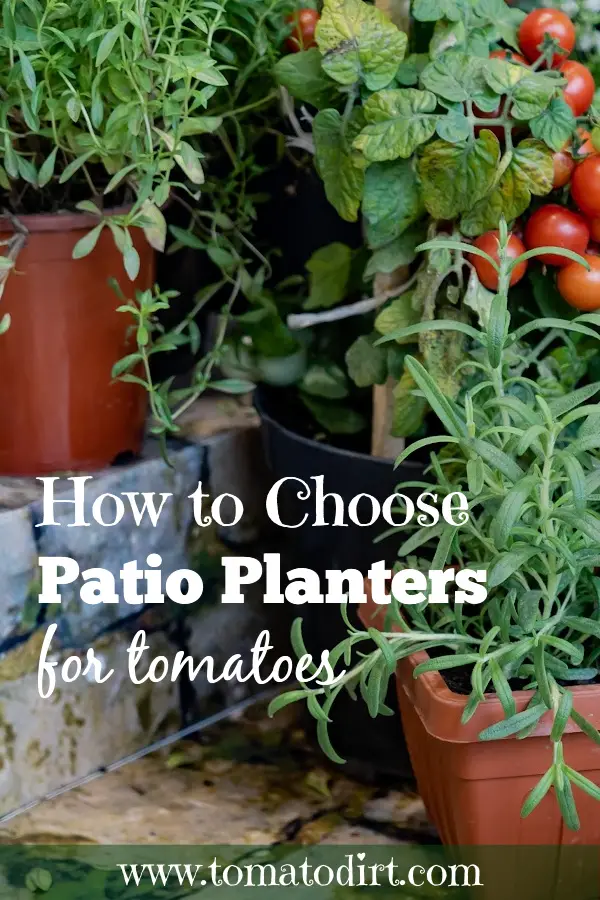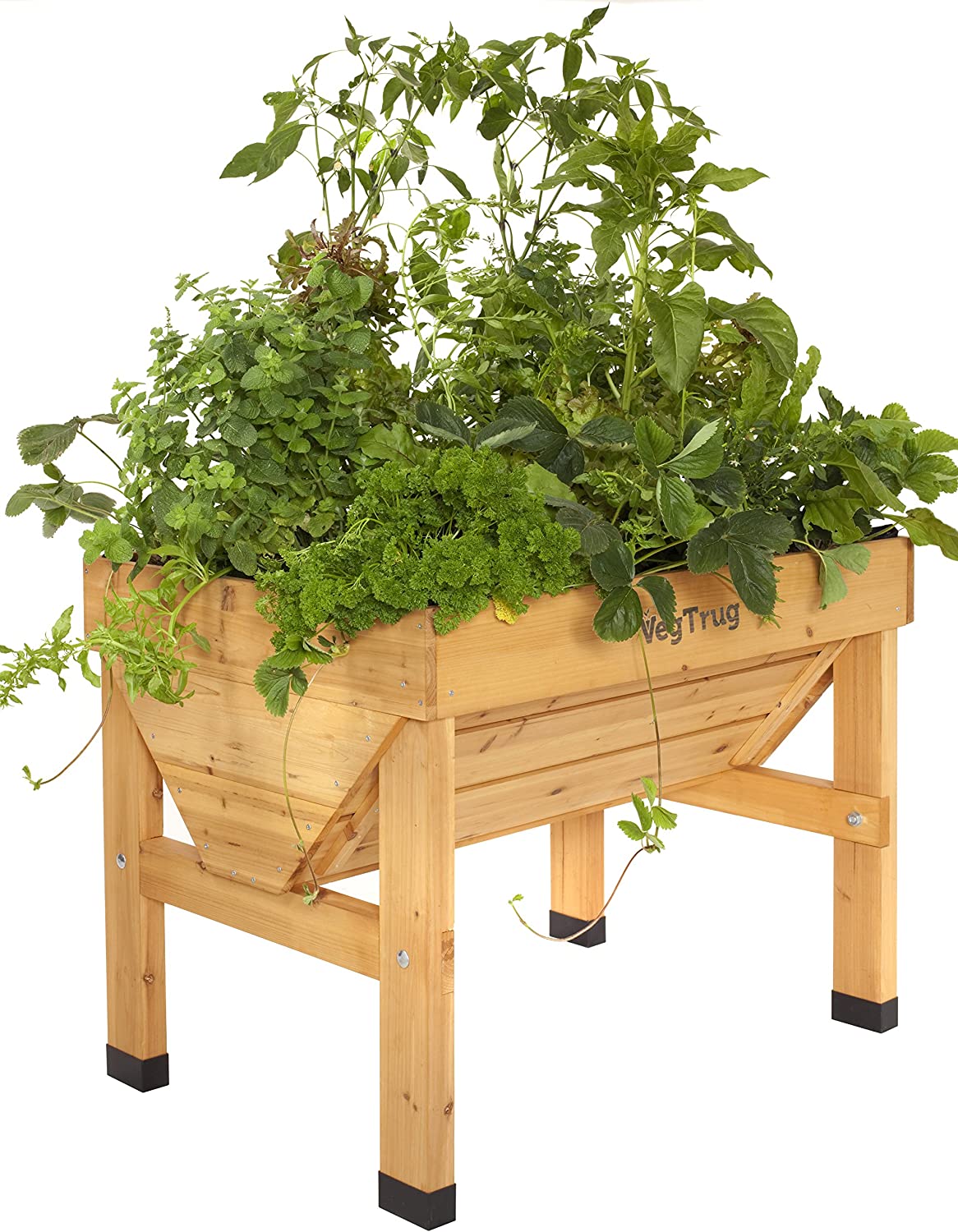FREE: 10 Must-Know Tomato Growing Tips Get The Guide
Read our affiliate disclosure here.
What to Look for in a Patio Planter for Tomatoes
Since 2010, Tomato Dirt has garnered 4.8+ million views, making it the web’s leading online source for growing tomatoes in the home garden. Award-winning writer and Tomato Dirt owner Kathy Widenhouse has helped thousands of home gardeners grow healthier tomatoes. Be one of them when you get Tomato Dirt’s Growing Guide here.
You don’t need a full-blown garden to grow tomatoes. Regardless of your access to real estate, you can use a patio planter for tomatoes anywhere you have a sunny spot, whether it's on a balcony, deck, driveway, porch, rooftop – even a fire escape.
And a patio planter for tomatoes is a great gift, too!
There are plenty of helpful tips for growing tomatoes in pots. You need pick a sunny location. Choose small tomato varieties. Create a watering schedule.
But growing tomatoes in pots starts with choosing the pot.
And this decision takes special care. Tomatoes are a unique crop, particularly if you plan to grow them in containers. With so many pots and containers available to choose from, how can you know what to look for in a patio planter for tomatoes? These tips will help.
When choosing a patio planter for tomatoes, consider …
1. Size
A common gardening mistake is to select a pot that is too small. When you’re choosing a patio planter for tomatoes, the bigger the better. Tomato plants are heavy feeders and have large root systems. If a container is too small, the plant’s roots get crowded and fight for water and nutrients. Rootbound tomato plants produce fewer fruit, get stunted, or wilt.
The most successful container gardeners choose larger containers that hold 5 gallons or more in volume. Even varieties that are supposed to grow well in 1- or 2-gallon pots will likely do better in a larger pot. When in doubt, choose a larger pot rather than smaller.
How big? Here are good tips to follow:
- Choose a patio planter for tomatoes which is at least 2 inches wider than the plant’s mature diameter and 2 inches deeper than the plant’s mature roots. In practical terms, that means at least 18-inch diameter for determinate tomatoes and 24-inch diameter for indeterminate tomatoes.
- Tall patio planters mimic conditions in the garden. Choose the tallest planter you can.
- If your prospective container is measured by volume, choose one that can hold at least 20 gallons.
When first planted, your tomato plants will look dwarfed in a large pot. Give them a few weeks. They bush out and gain height quickly. By mid-season you’ll be thankful you chose a large pot.
If you have plenty of space, or if you want to grow more than a couple of container tomato plants, you may consider choosing a raised bed. Your raised beds can be as large or small as you choose. A good rule of thumb to follow is that they should be no wider than 4 feet on one side. This allows you to reach in from both sides to weed, cultivate, and harvest plants.
2. Drainage
When you choose a patio planter for tomatoes, check for good drainage.
Tomatoes grow fast and they build deep root systems. They need plenty of water. Roots can only extend so far and are halted by the container’s sides. Containers dry out quickly because their sides limit soil and water volume. On the other hand, if planters have no way to drain properly, a tomato plant’s roots can become water logged and vulnerable to root rot.
Holes in the container bottom allow excess water to drain properly. A drip tray like the one used on the large outdoor planter above can help protect the surface beneath it from water rings and damage. A drip tray also allows the plant’s deep roots to continue to absorb water excess water before it evaporates.
Fabric containers, of course, don’t need drainage holes. But their porous texture means they dry out even faster than other types of planters.
That’s one reason all containers, regardless of material, should also have enough room at the top to allow for adequate watering. You may also want to consider a simple and affordable deck irrigation kit or a drip irrigation kit for container gardening. You can even set the drip hoses on a water timer.
3. Material
The most common container materials are terra cotta, clay, plastic, wood, concrete, fiberglass, composite, cast iron, and metal. Fabric, too, is beginning to grow in popularity.
Natural materials lend themselves to good circulation, which is useful for preventing the spread of fungi, tomato blight, and powdery mildew in growing tomatoes.
But before you run out to purchase your favorite look for your patio, consider a few practicalities. Terra cotta and unglazed pottery can dry out quickly. Also, extreme changes in temperatures can make pottery crack more easily than other materials. You may need to replace clay pots more often than containers made of something else and monitor tomatoes in these containers often to make sure they get enough water. And while fabric containers won’t shrink and expand in the same way as pottery, they are less long-lasting and porous, too.
On the other hand, a plastic patio planter for tomatoes can easily withstand freezing and thawing. And plastic retains water more effectively. The only challenge is a container made of black plastic, which absorbs excessive heat. Tomato Dirt’s recommendation: choose a plastic patio planter for tomatoes.
If a plastic container doesn’t convey the look you want in your patio garden, you can pot up tomatoes in plastic pots and insert them into a more attractive container made of wood, metal, terra cotta, or other material. Make sure both containers have adequate drainage.
4. Height
Raised beds provide an attractive planter alternative for growing tomatoes. They’re set above the soil line but allow roots to extend deeply into the soil beyond their raised edges. Keep in mind, though, that you are not able to move raised beds that are built in a permanent spot.
That’s one reason a movable elevated patio planter is becoming an increasingly popular option. And if you have physical challenges, you might consider a no-bend patio planter. The ideal height is up to you. Some gardeners, particularly the elderly or disabled, prefer raised beds that are waist high.
By using an elevated planter like the VegTrug line of products you can grow plants at an easy working height and avoid bending or kneeling. VegTrug’s V-shape allows you to grow tomatoes and other deep-rooted crops at the center and companion plants around the edges.
https://www.gardeners.com/search?q=VegTrug+planter
Bonus tip: choose a self-watering tomato planter for tomatoes
A self-watering tomato planter is a movable container that solves many of the choices you need to make about choosing a patio planter for tomatoes.
- It’s made specifically for growing tomato plants, so its size and materials are appropriate.
- It all but takes away the main obstacle to growing tomatoes successfully in containers: watering and drainage.
One of the more popular self-watering tomato planters for home gardeners is Tomato Success Kit by Gardener's Supply.
What’s the best planter for tomatoes?
Bottom line: to grow tomatoes in pots, you need …
- A good-sized container
- A container with adequate drainage
- A container made of durable material
If your container meets those qualifications, and it works for your situation, then it’s the best tomato planter for you.
More Tips for Choosing a Patio Planter for Tomatoes
5 Tips for Planting Tomatoes in Pots: Plan for Success ...
Tips for growing cherry tomatoes in containers ...
Review: Self-watering tomato planter of Tomato
Success Kit ...
Tomato bags are sturdy, grow healthy tomatoes ...
Do Container Tomatoes Need Staking?
Growing tomatoes in pots: basics you need to know ...
Check out more container tomato ideas on our Pinterest board...
Return from Patio Planters for Tomatoes to Tomato Dirt home
As an Amazon Associate and Rakuten Advertising affiliate I earn from qualifying purchases.
SHARE THIS PAGE:
FREE! 10 Must-Know Tomato Growing Tips: 20-page guide
Get yours here:





